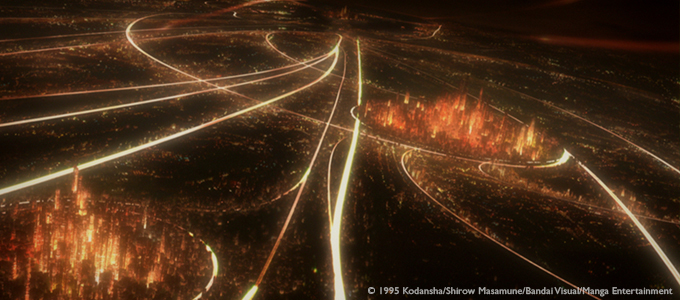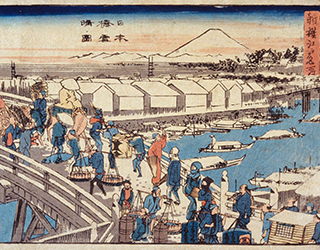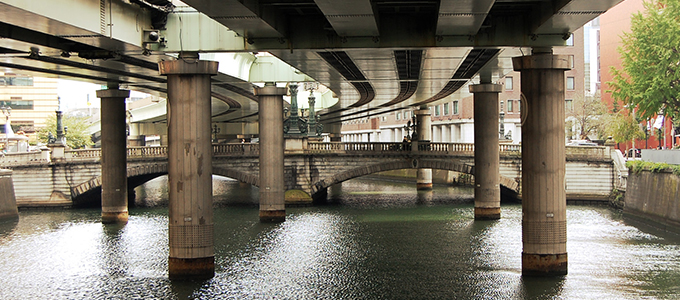
The Lifetime of Coral Reefs
Director Mamoru Oshii often points out that the city of Tokyo resembles a coral reef.
Noticeably, most of the coral reef consists of dead matter. Only the living coral polyps that are attached to the surface are alive. Unlike its close cousin, sea anemones who independently thrive, the coral is a cluster. Furthermore, they are a cohesive bunch. Even if they split and multiply they are firmly attached to one another. As they cluster, they don’t all die together. Rather, they live parasitically on the “castle of carcass,” an accumulation of the dead matter from former living coral.
“The people living in Tokyo are the same as the coral polyps that live on a reef: they are parasitically living in the capital. They think that the city is merely a host, and not part of their own body. That is why no one seriously wants to take care of Tokyo, nor do they want to preserve it.”

“However, if you look at world history, the capital city is supposed to be the physical representation of culture itself. Including its memory, of course. In reality, if the people who live there don’t seriously take care of it as if it’s their own body, you can’t say that they love their city.”
“Civilization starts and ends with the city. The idea of comparing city and nature is obsolete and for a city dweller the surrounding has become much like his or her natural environment. So then we think, why does man build cities, and why do so many people live in them? That is the act of grasping the whole picture and understanding that a city is a physical entity of culture itself. But there are very few residents left who think that way in Tokyo.”
As a citizen of Japan, how should we look at Tokyo? This also raises questions of how to see Japan as a country, and how to preserve it. If we settled with the attitude that comfort and abundance is all we need, we might become a really vulnerable city or nation. This is something that particularly those Japanese living in Tokyo need to contemplate seriously.
“What are the necessary functions of a nation’s capital? Furthermore, can we maintain these functions during and after large disasters or even nuclear attacks? These are the basic issues. Of course, it is not just about technical issues. Before that, we need to talk about how Japanese view the condition of their capital. To me, it doesn’t look like anyone is really thinking about this.”
“It is essential to comprehend the city from a political, military and cultural point of view. There is no use thinking of these aspects separately. That’s because they are all intimately intertwined. I have often discussed the capital from a military standpoint, but that is just my pointing out the antithesis of how we understand our city. What I want to say is that if you approach the city from just a utilitarian standpoint, something terribly wrong will happen. Only focusing on military logistics doesn’t cover the whole picture, either.”

“Sentiment is a necessity for a city, of course. From Nihonbashi Bridge (the center of Tokyo), you can choose to relax and enjoy the river, or you can choose to look up at the highway that passes over it. That is just a symbolic example, and therefore to make my point clear, I plunged a missile into that Nihonbashi Bridge in my movie for choosing to be the latter choice. Thus, unless we change our point of view on how we look at our city, we can’t say that we are actually getting a grasp of what it is.”
Oshii destroys to prove the opposite. In human instinct, behind the desire to severely damage and destroy, there is a complex bond that comes with not wanting to lose what one loves. Wake up, before Tokyo or our motherland Japan turns into a giant block of coral reef! That, probably, is the message behind all his destructive expression.
“From the start, within the limited culture of animation, cities have consistently been the object of destruction. And it’s still being done. I went overboard on this, too. It’s all the same, whether you are eliminating the city with extra sensory perception like AKIRA, or using three attack helicopters to symbolically destroy it, like I did.”
“What I am trying to say is: we need to decide if we love our city or not. Why don’t we make that clear? It's the same as questioning if you love your own body or not. If you hate it, then you will have to turn it into a body that you are able to love. Ask yourself what this lovable body looks like. If you can’t imagine that, then you are only able to love it superficially, like a parasite. I haven’t the slightest clue about what the urban planners envision for today’s Tokyo.”
“There are people who believe that changing the leader through elections can change society. Even if you change your boat captain, however, nothing happens until the actual boat is changed. Just like a steamboat moves at a steamboat’s pace, a sailboat may sometimes go against the wind, but then again a steamboat may not go anywhere without coal. Without contemplating the limitations of the boat, there is no use changing the captain. There are fewer and fewer people who can think in this basic way.”
Coral has no real life span. But it is said that it may continue to exist in oblivion for thousands of years. Do we want to demolish or do we want to build our city and nation? It seems about time the human coral reef made this very clear.
(Interview: Manami Iiboshi, Translation: Mika Anami)
